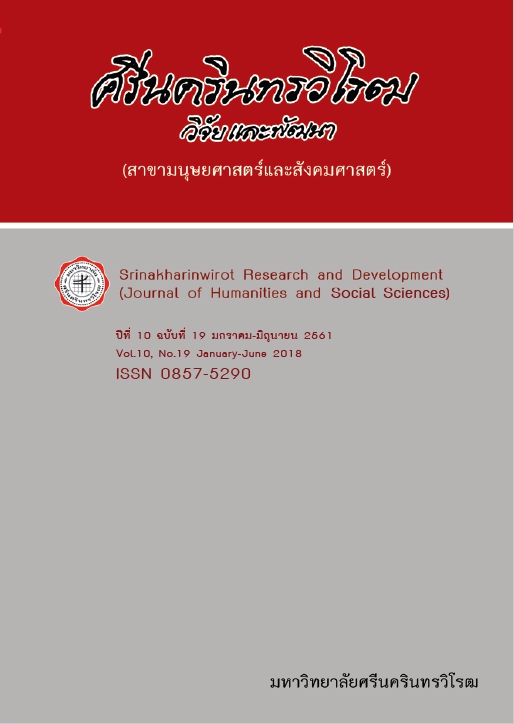อัตราผลตอบแทนจากการลงทุนทางการศึกษาวิทยาลัยเอกชน กรณีศึกษา: คณะพยาบาลศาสตร์ (RATE OF RETURN ON PRIVATE COLLEGE: CASE STUDY OF FACULTY OF NURSING)
Keywords:
Investment in Education, Private Rate of ReturnAbstract
The objective of this research were to study rate of return on private college case study of faculty of nursing chiangrai college. This study consist of 1) The direct and indirect private cost of graduates per head 2) The estimated of graduates income and 3) An analysis rate of return on investment in education. The populations for study is the graduates from nursing faculty, Chiangrai College. The results of the study found that 1) The graduates total private cost per head was 1,023,324.736 baht which consist of the direct and indirect private costs were 600,000 and 423.324.736 baht. 2) an estimated from graduates income found that the higher work experiences graduates has higher income than the lower work experiences graduates. Those who worked in private sector earned higher income than those who worked in government sector and 3) an analysis rate of return found that benefit-cost ratio for total graduates was 266.86, for those who worked in the private sector was 342.08 while of those who worked in government sector was 222.84. Internal rate of return total graduates was 28.84%, for those who worked in private sector was 31.97% while of those who worked in government sector was 26.76%.
Downloads
References
[2] Cohn, E. and Geske, T.G. (1990). The Economics of Education. 3rd ed. New York: Pergamon Press.
[3] Psacharopoulos, G. (1981). Returns to education: an updated international comparison. Comparative education. 17(3): 321-341.
[4] Psacharopoulos, G., & Patrinos, H. A. (2004). Returns to investment in education: a further update. Education economics. 12(2): 111-134.
[5] ชัยยุทธ ปัญญสวัสดิ์สุทธิ์. (2551). คุณภาพของทุนมนุษย์กับการเติบโตอย่างยั่งยืน ทุนมนุษย์กับผลตอบแทนทางการศึกษาสู่การเติบโตอย่างมีคุณภาพและยั่งยืน. การสัมมนาวิชาการประจำปี 2551 คณะเศรษฐศาสตร์ มหาวิทยาลัยธรรมศาสตร์.
[6] Card, D. (2001). Estimating the return to schooling: Progress on some persistent econometric problems. Econometrica. 69(5): 1127-1160.
[7] คมกฤช รัตนธรรม. (2548). อัตราผลตอบแทนส่วนบุคคลของการลงทุนทางการศึกษาระดับปริญญาตรีจากมหาวิทยาลัยเชียงใหม่. วิทยานิพนธ์เศรษฐศาสตรมหาบัณฑิต มหาวิทยาลัยเชียงใหม่.
[8] นิจพร บานนิกุล. (2549). อัตราผลตอบแทนส่วนบุคคลของการลงทุนทางการศึกษา: กรณีศึกษาหลักสูตรปริญญาโท สาขาวิชาการบัญชี คณะบริหารธุรกิจ มหาวิทยาลัยเชียงใหม่. การค้นคว้าอิสระบัญชีมหาบัณฑิต มหาวิทยาลัยเชียงใหม่.
[9] สำนักงานคณะกรรมการข้าราชการพลเรือน. (2558). การเลื่อนเงินเดือนข้าราชการพลเรือนสามัญ. สืบค้นเมื่อ 9 สิงหาคม 2558, จาก http://www2.ocsc.go.th/หนังสือเวียน/ว6-2558-การปรับเงินเดือนเข้าสู่บัญชีเงินเดือนขั้นต่ำขั้นสูงของข้าราชการพลเรือนสามัญ.
[10] ธนาคารแห่งประเทศไทย. (2558). อัตราดอกเบี้ยเงินให้สินเชื่อของธนาคารพาณิชย์. สืบค้นเมื่อ 9 สิงหาคม 2558, จาก https://www.bot.or.th/thai/statistics/financialmarkets/interestrate/_layouts/application/interest_rate/in_rate.aspx
[11] Krejcie, R.V., & Morgan, D.W. (1970). Determining Sample Size for Research Activities. Educational and Psychological Measurement.
[12] Ponlapat Buracom. (2549). The New Development of Endogenous Growth Theory and Inefficiency Problem in the Allocation and Distribution of Public Spending in Education. Retrieved August 1, 2014, from https://www.tci-thaijo.org/index.php/NDJ/article/view/2683/2056
Downloads
Published
How to Cite
Issue
Section
License
Srinakharinwirot Research and Development Journal of Humanities and Social Sciences is licensed Under a Creative Commons Attribution-NonCommercial-NoDerivs 4.0 International (CC-BY-NC-ND 4.0) License, Unless Otherwise Stated. Please Read Journal Policies Page for More Information on Open Access, Copyright and Permissions.



